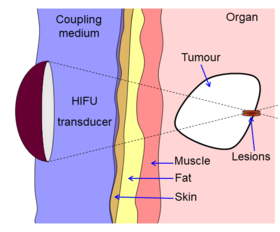This article contains promotional content. (January 2015) |
High-intensity focused ultrasound (HIFU), or MR-guided focused ultrasound surgery (MR-guided focused ultrasound ablation), is an incisionless therapeutic technique[1] that uses non-ionizing ultrasonic waves to heat or ablate tissue. HIFU can be used to increase the flow of blood or lymph or to destroy tissue, such as tumors, via thermal and mechanical mechanisms. Given the prevalence and relatively low cost of ultrasound generation mechanisms, the premise of HIFU is that it is expected to be a non-invasive and low-cost therapy that can at least outperform care in the operating room.
The technology is different from that used in ultrasonic imaging, though lower frequencies and continuous, rather than pulsed, waves are used to achieve the necessary thermal doses. However, pulsed waves may also be used if mechanical rather than thermal damage is desired. Acoustic lenses are often used to achieve the necessary intensity at the target tissue without damaging the surrounding tissue. The ideal pattern diagram is the beam-focusing of a magnifying glass of sunlight; only the focal point of the magnifying glass has high temperature.
HIFU is combined with other imaging techniques such as medical ultrasound or MRI to enable guidance of the treatment and monitoring.
